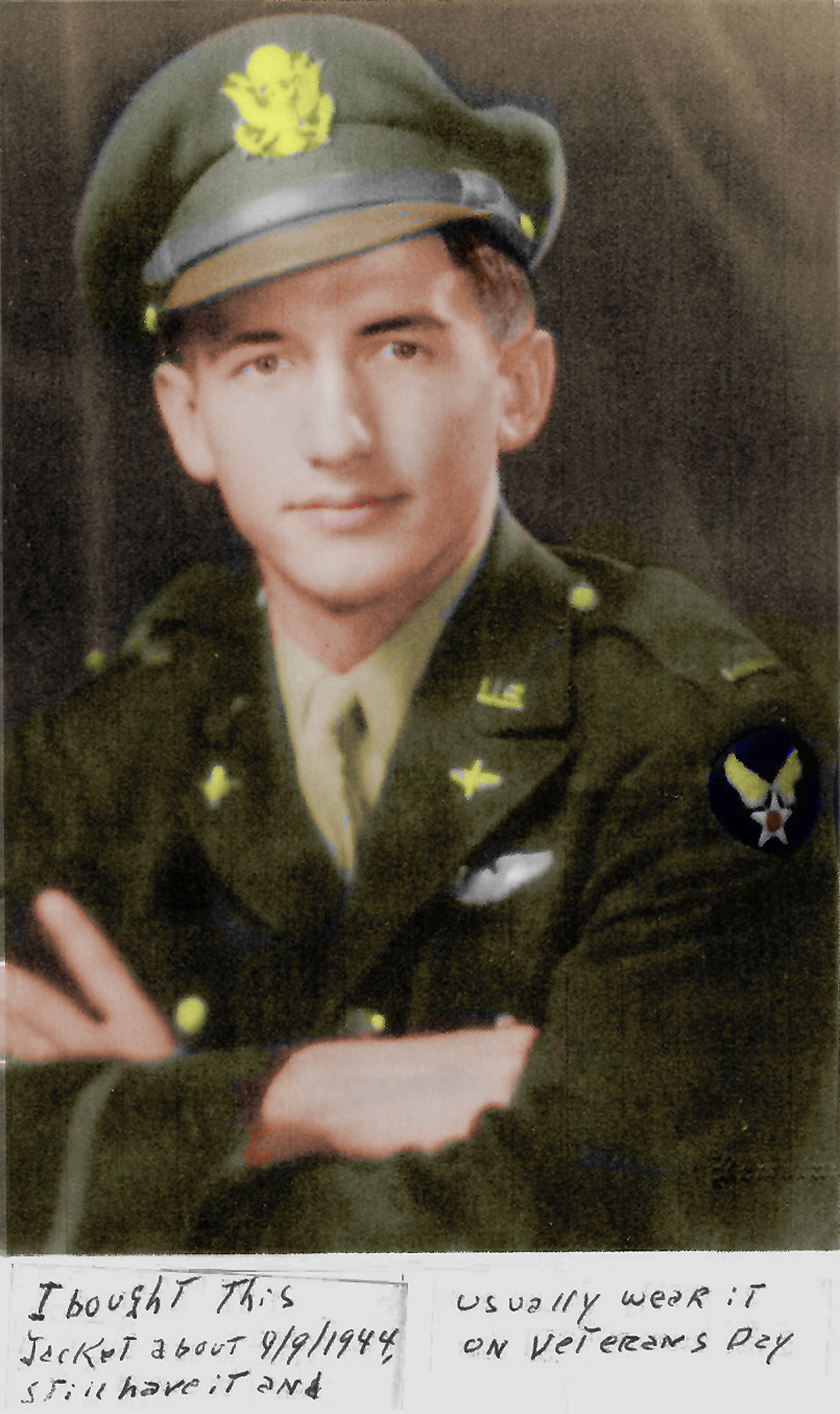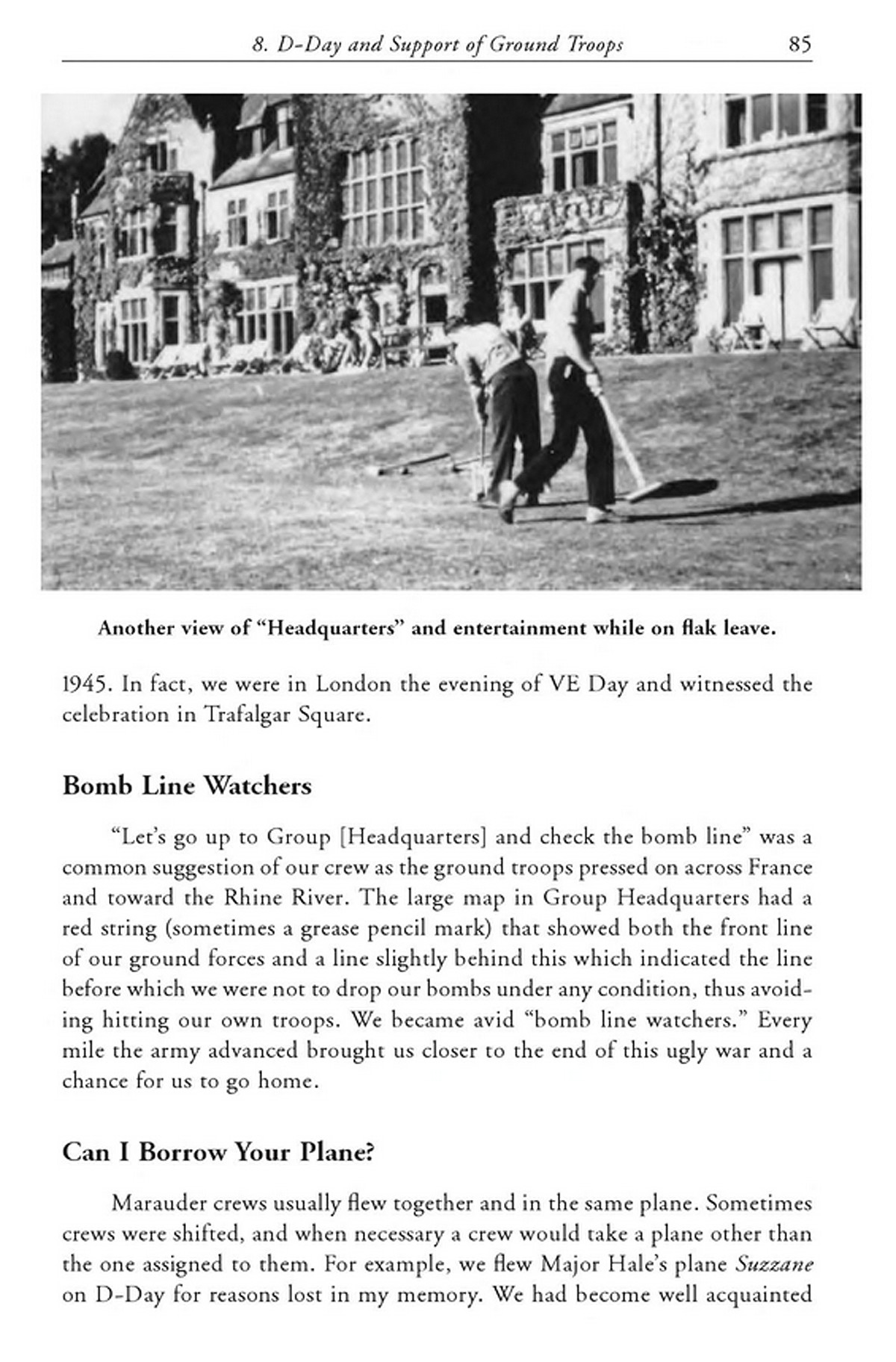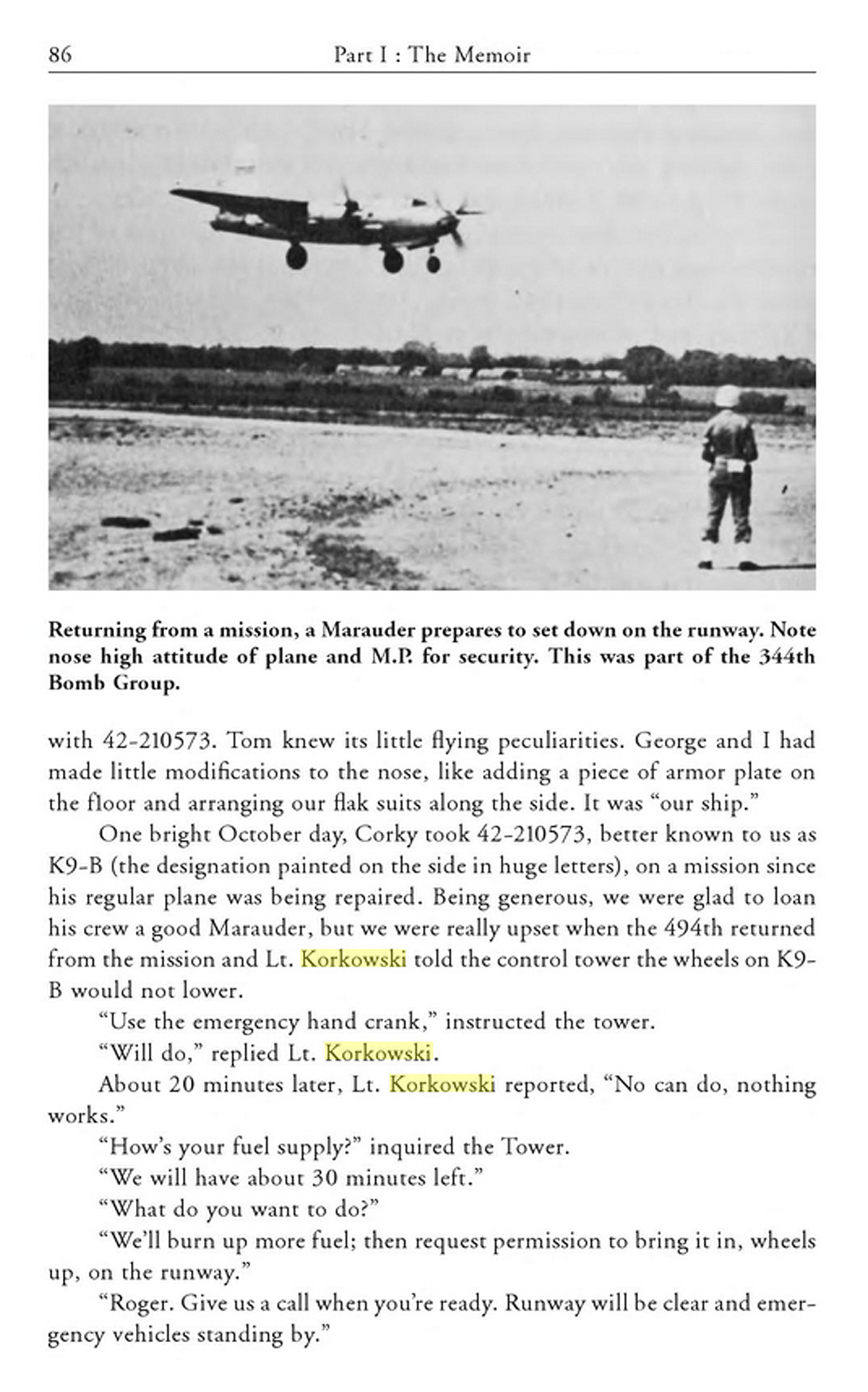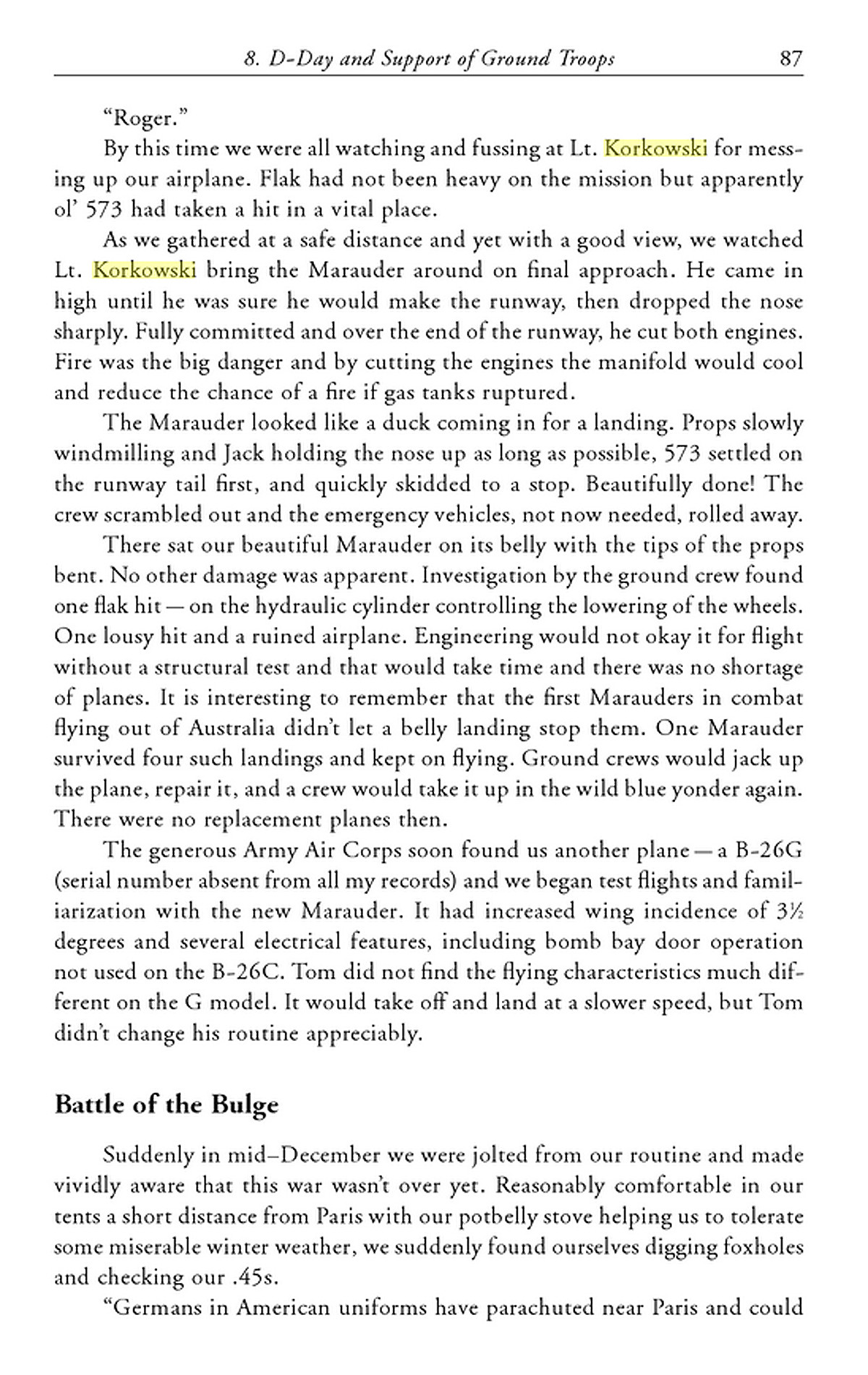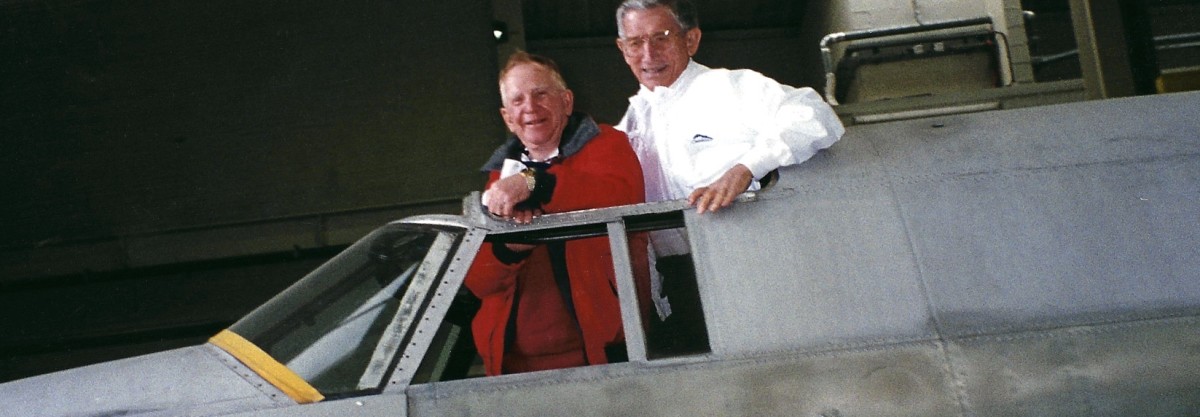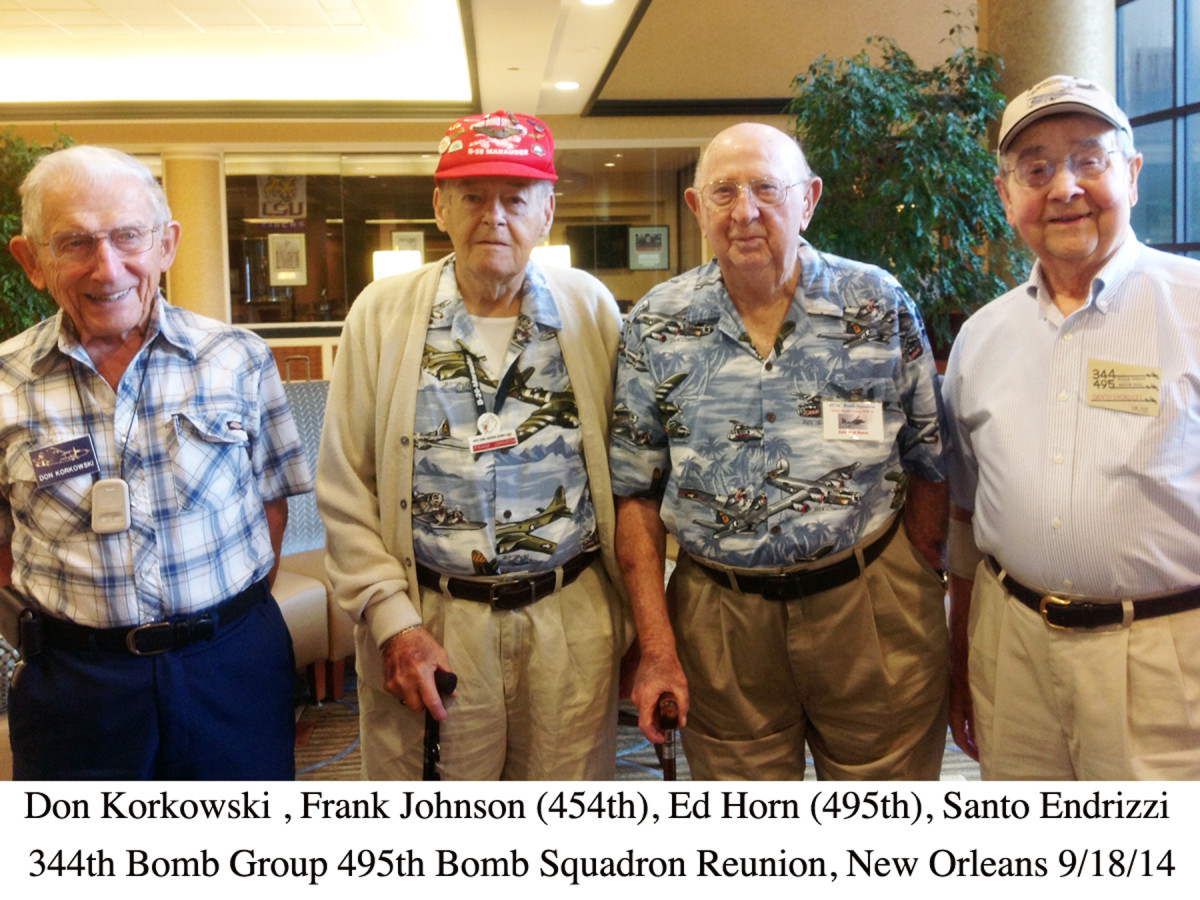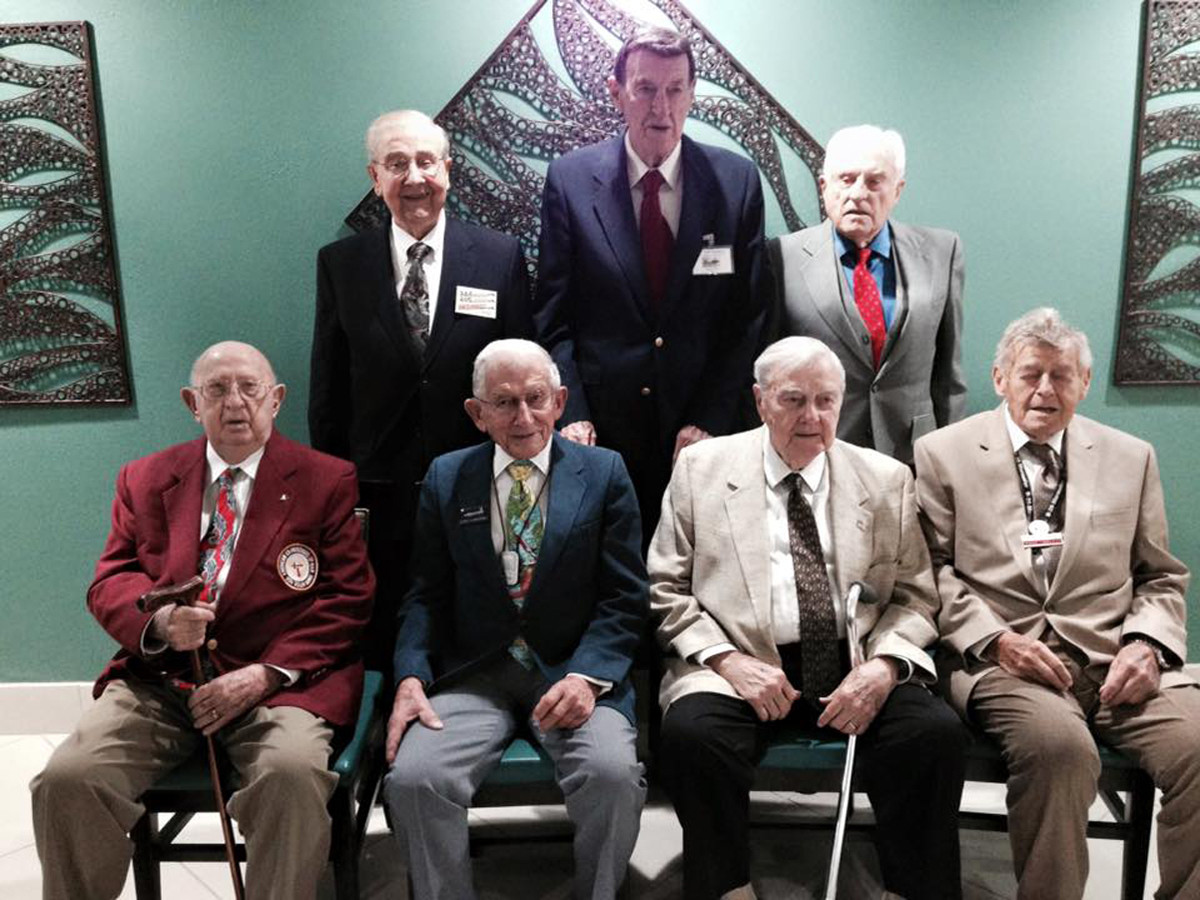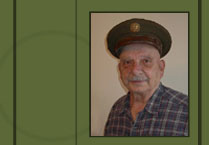Lt. Don (Corky) Korkowski
Corky Korkowski
Autobiographical sketch (Find the full autobiography at end of this post)
More bout Corky:
Korkowski’s Controversial Picture
Click any photo to enlarge
“My life began on a farm in Minnesota and education began with 8 years in a wonderful one room country school. A small pox epidemic destroyed my appointment to West Point due to a heart murmur it brought on. I don’t know whether I got the small pox or whether I just got so sick from the shot the doctor gave me to prevent getting small pox. I started working my way through the St Cloud State Teachers College. A year later, I enlisted in the Army Air Corps, became a B-26 pilot and flew 43 combat missions including 2 crash landings returning from those missions. I began my 10 month tour of duty in Europe about September 28, 1945 and it ended in late July or early August, 1945. Upon returning from the war, in spite of my lack of education, I was assigned to the legal office and assigned to trying court-martials and board proceedings. After 2 years, I got out of the military and went to law school at the University of Illinois. Upon graduation, I was immediately recalled for the Korean War and served 18 months mainly as a trial lawyer in the legal office. Then I practiced law in civilian life for 32 years. The first half was as a trial lawyer and the last half as a business lawyer in banking, cable television, pension & profit sharing, and estate and retirement planning. Now I have thoroughly enjoyed retirement for 32 years.”
History with the 344th BG 494th BS:
1st Lieutenant Don (Corky) Korkowski became a Pilot when just 20 years old and a combat instructor at 21. He trained thirteen co-pilots who eventually piloted their own crews acting as pilot while the candidate pilots acted as co-pilot. Corky flew 43 missions total. He flew in the European Theater of Operations starting 9/28/44 based in Cormeilles, France, with the 344th BG 494th BS. He completed his tour after V.E. day, in late July or early August, 1945.
Not all 43 missions went smoothly. Corky was involved in two crashes and other incidents of particular note:
See incidents as per Korkowski’s description followed by “Semi-Official Records” of three crashes (note there are discrepancies with dates. Corky’s memory and notes are good. I believe we should defer to his data;
1. “On March 24, 1945 I crash landed the commanders plane. The landing gear were shot up so I was forced to belly-land the plane. The plane was determined to be beyond repair.” “My commanding officer was Lt. Col. Tom Johnson. I also flew as a wing man with him on a strafing mission. We didn’t “borrow” a plane assigned to someone else; authorities merely assigned the use of another plane to use for a flight.”
Semi-Official Records: 42-107573 K9-B Tom’s Tantalizer II- The aircraft was named after the pilot 1st Lt. Tom Johnson, by her ground crew. The nose art was painted by the crew chief, Mike Ondra. 1st Lt. Johnson was later promoted to Major. Crash landed after the hydraulics were damaged on a mission on 11/9/44 (Sept 11, 1944). The undercarriage would not lower and the aircraft belly landed back at base. Lt. Korkowski had borrowed this aircraft from its regular combat crew. The aircraft which suffered Cat.B damage was sent to the service group for repair, and was returned to the squadron on 14/1/45, where it was recoded K9-H. The aircraft flew 61 missions as K9-B, plus another 36 missions as K9-H. The record card lists, GLUE 9AF CON ALS on 13/9/44, and GLUE 9AF REPAIRED on 6/11/44. This infers that the aircraft force landed at an Advanced Landing Strip (where?), not it’s home base, and was repaired. This ties up with the time frame of the belly landing, so needs conformation. The final entry on the record card lists, GLUE CON SAL FEA (9th AF) on 22/1/46.
2. As if that was not enough excitement, on the next day, March 25, 1945 he crashed landed another plane (K9-S *44-67821 K9-S). “The next day, after dark, I led six planes, including my own, that were low on fuel into a front line base at St. Trond, Belgium. I contacted our home base at Pontoise, France and reported that we were on the ground. They told me to leave the others there overnight and, because bad weather was causing the ceiling to drop rapidly at Pontoise, that I should come home immediately. They said I had more experience flying in bad weather and they needed me for the mission the next day. I told them that I knew I had some battle damage and needed to check the plane. I was told that time was more important and that I got down without trouble so I should get 250 gallons of fuel and get going. The take off run was going normally and we were about a foot off the ground and I was giving the copilot the wheels up signal at about 120 miles per hour when the left engine suddenly quit. Torque was instantly turning us over and the left wing hit the ground and we spun around. Expecting a fire, all of us got out as quickly as we could. The co-pilot and I went through the top windows and jumped about 15 feet to the ground in the darkness with our parachutes on our backs. This was the start of my back trouble. My official Individual Flight Record (a copy is or should be in my VA file) shows that I was thereafter on ”Flight Restrictions 9 days Medical” and that I didn’t fly again for 18 days. I have no memory of whether I was hospitalized. The tail gunner was temporarily knocked out being hit by a 50 caliber machine gun that broke off its mount. My only memory was that I saw him in the hospital trying to eat and that he was shaking so badly that he was eating with his fingers instead of a fork and was having trouble finding his mouth.”
Semi-Official Records: 44-67821 K9-S Entered combat with the 344th BG / 494th BS on 25/12/44. Damaged Cat.3 in a take off accident at A-92, St.Trond Airfield, Belgium on March 21, 1945. The aircraft flown by 2nd Lt. Donald J Korkowski crashed shortly after take-off and was salvaged. Other crew on board were: 2nd Lt. J A Swarm, 2nd Lt. H S Dieches, Sgt. A G Hughes, Sgt. E J Perkosky, and, Sgt. J V Cowan.
3. 43-34419 K9-B 2nd Lt. D J Korkowski
The aircraft was flown overseas to the 9th AF in the UK via the Northern Ferry Route, departing the USA on 8/7/44. Entered combat with the 344th BG / 494th BS on 23/9/44. Suffered flak damage on the 3/20/45. The aircraft flown by 2nd Lt. D J Korkowski crash landed back at base, A-59 Cormeilles-en-Vexin, France, and was salvaged. The final entry on the aircraft record card lists, GLUE 9AF CON SAL NBD on 22/3/45.
4. “On 2/13/45 was the Euskirchen mission. Hugh Yeager and his crew were flying in #3 position and we were in #2 and our wings were almost touching. I flew with a strange crew that day except for my tail gunner. We experienced moderate, accurate flak and carried 16-250 lb. bombs per my record, however, my memory tells me that we carried 2- 2,000 lb. bombs. Yeager’s plane, just 100 feet beside us got hit in the bomb bay right at “bombs away.” The plane exploded. I lost most of my hearing from the explosion and I recall seeing a gear fly past our windshield. All aboard were killed except the tail gunner, Norman Dwight, who was in the tail when it broke off in the explosion. It seems he had time to take off his flak suit, put on parachute and bail out. He was captured and later visited me (Corky) after pow camp but before going back to states. After that, I lost touch with him for 35 years. I finally got in touch with him by phone. Norman Dwight died three or four years ago (2011?). The reason why he felt I was important enough for hime to come to see me was because he I flew with his crew during Dwight’s first mission in a training capacity. Dwight was shot down on only his second mission. The pilot, Hugh Yeager, was a good friend of mine. (A question for Corky: Was Norman Dwight tail gunner or turret gunner? Official record says turret, you said tail gunner)
“Official” record of above: 42-95921 Old Relic K9-C 344th BG 494th BS Pilot 2nd Lt. Hugh Levant Yeager (killed), co-pilot 2nd Lt. Robert John Forden (killed), bombardier/navigator F/O Neil William Boylan (killed), radio/gunner Sgt. Otha Wilson Hesler (killed), turret gunner /engineer Sgt. Norman Eugene Dwight (bailed out, POW), tail gunner/armorer S/Sgt. Charles Woodrow Bloucher (killed)
Original group aircraft. Shot down by flak over the target, just before releasing its bombs on the 2/13/45 mission to the Railroad bridge at Euskirchen, Germany. The aircraft flown by 2nd Lt. Hugh Levant Yeager was hit in the forward bomb bay, it burst into a ball of flame and the left wing folded under. The fuselage broke into two pieces and fell to earth. Only one crew member managed to bail out and survive, the engineer, Sgt. Norman Eugene Dwight who was captured. The rest of the crew were killed. The pieces of aircraft came down 600m NE of Cuchenheim, about 4 km SE of Euskirchen, Germany.
| 13-Feb-45 | 12221 | Two aircraft shot down. 12 personnel listed as missing -in-action. | ||
| Euskirchen | 2nd Lt. Hugh L. Yeager, Jr., Pilot, O-715914(KIA, Zachary Taylor, KY) | |||
| RR Bridge | 2nd Lt. Robert John Forden, Co-Pilot, O-709559(KIA, King City, CA) | |||
| 494th bs | F/O Neil William Boylan, Bombardier, T-128939(KIA, Zachary Taylor, KY) | |||
| 42-95921 | Sgt. Norman Eugene Dwight, Engineer-Gunner, 3941636 EUS | |||
| “Old Relic” | Sgt. Otha Wilson Hester, Radio-Gunner, 34803492(KIA, Zachary Taylor, KY) | |||
| K9-C | S/Sgt. Charles Woodrow Bloucher, Tail-Gunner, 35142958(KIA, Friendship Park, IN) | |||
This was a rough mission. At the same instant, the plane in front of Korkowski was shot down and the automatic bomb camera in his plane got a picture of it going down as it lost altitude and passed under them. Corky sent a copy of that picture. I have two versions of it. One Two.
See version two below.
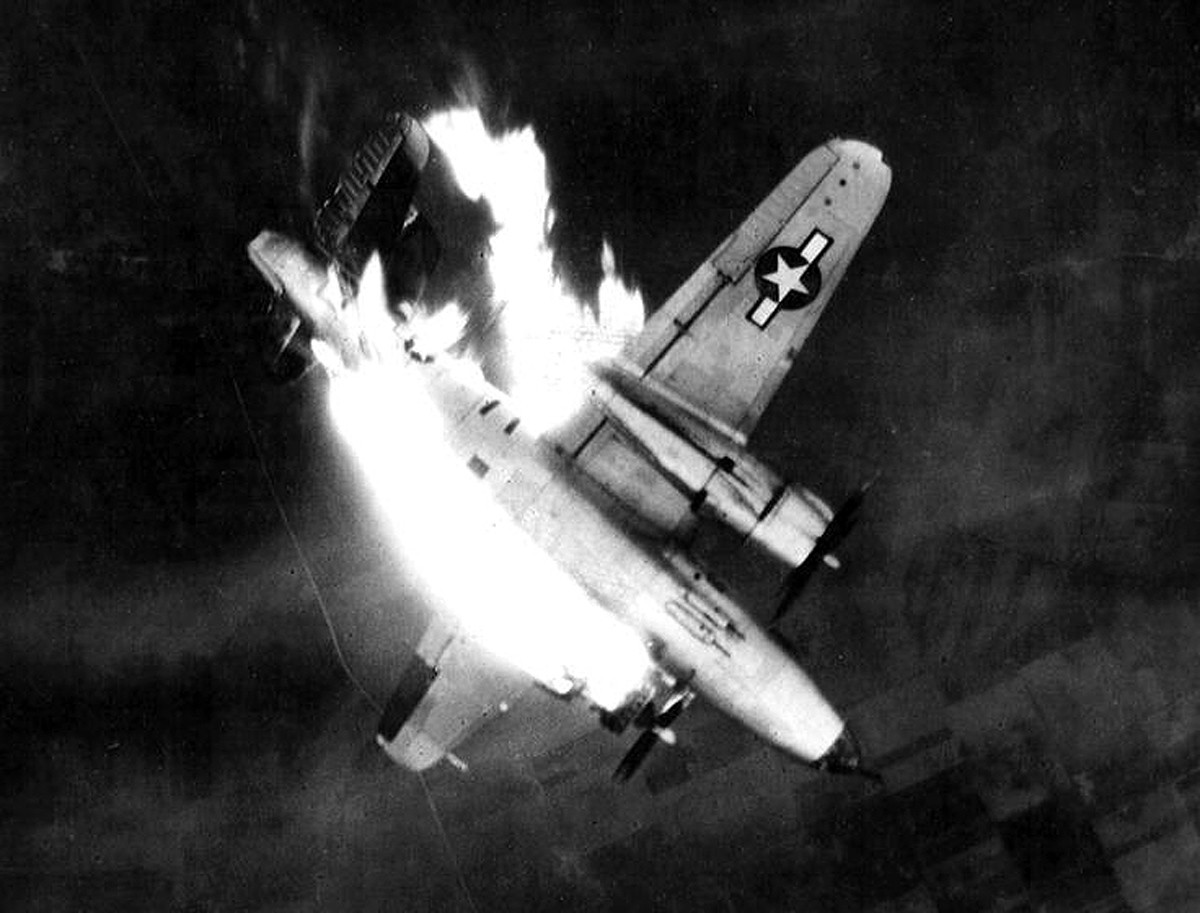
Bomber “Marauder” B-26, serial number 43-34565, Gratis Gladys, 7I-B, 497 Squadron, 344th Bombardment Group, 9th U.S. Air Force is crashing to the ground after receiving a direct hit in the left engine during the bombing of a Erkelenz, Germany, 26 Feb 1945. MACR 12649
…………………………..
“Official” record of above: Bomber “Marauder” B-26, serial number 43-34565, Gratis Gladys, 7I-B, 497 Squadron, 344th Bombardment Group, 9th U.S. Air Force is crashing to the ground after receiving a direct hit in the left engine during the bombing of a Erkelenz, Germany, 26 Feb 1945. MACR 12649
Capt. Carl Franklin Chapman (killed) Pilot
1st Lt. John Jack Sheehan (killed) Co-Pilot
2nd Lt. James Richard Harl (killed) Bombardier
1st Lt. Kenneth Gordon Bowdish (killed) Navigator
T/Sgt. J P Herndon (killed) Radio/Gunner
S/Sgt. Ballard James Bentley (killed) Engineer/Turret
S/Sgt. W T Williamson (killed) Tail Gunner/Armourer
1st Lt. Frederick Darwin Storey, Jnr – GEE operator (killed)
Shot down by flak and crashed on the 23/2/45 pathfinder mission to Erkelenz, Germany. The pilot was Capt. Carl Franklin Chapman, and co-pilot, 1st Lt. John “Jack” Sheehan, who was flying his 65th mission. The aircraft took a direct hit in the left engine just after bombs away, burst into flames, flipped over and spun into the ground, exploding on impact near the target area. All the crew were killed. We also had this aircraft listed as K9-G of the 494th BS. Transferred maybe from the 494th BS to the 497th BS? Needs confirmation. (note date discrepancy from Corky’s description of events.)
5. “Another memorable experience was landing the B-26 “dead stick” returning from another mission. I reported being low on fuel so the tower asked me to circle over the field while they landed other planes that were severely battle damaged. Then I reported running out of fuel on one engine. The tower said to continue circling because they still had one severely damaged plane to land. Then I reported running out of fuel on the last engine and the tower said, “You are number one to land”. Wild Bill Young had taught me that the B-26 did have a glide slope!”
6. “Approaching the runway as we were returning from another mission, the watchman at the approach-end of the runway, signaled for me to cut my engines. After we came to a stop, we learned that we were leaving a trail of gasoline behind because we had a flack hole in a gas tank.”
7. “During the Battle of the Bulge, ((16 December 1944 – 25 January 1945)our radio-gunner, Perky Perkosky, was hit on the shoulder with a piece of flak. Other crew members took off his jacket but couldn’t see that the flak had penetrated his flight suit and they couldn’t find the flak. The next morning, Perky came to my tent crying with joy as he had gone to blow his nose and found the flak in his charred handkerchief.”
8. “On another mission, a piece of flack came straight at me, creased the top of the nose of the B-26, cut the roll of wires that came across the top of the dashboard, and then we couldn’t find why it never hit me. After landing, we found it on the floor in front of me and determined that it had struck the wheel and fallen on the floor.”
9. “On 2/3/45 Nassau mission by my records and 2/2 by the records of Robert D. Conrad http://shopwornangel.imaginarynumber.net/captain-robert-d-conrad-pilot-344th-bg-494th-bs/, we flew the mission with a strange co-pilot and bombardier, carrying 2- 2,000 lb. bombs. We experienced weak but accurate flak, saw much of Germany as we circled waiting for one flight to bomb. One bomb failed to release and bombardier Goyer had to go into the bomb bay and release it by hand.”
Asked how he managed to survive these close calls, Korkowski gave credit to a pilot known as “Wild Bill.” “Wild Bill Young was a fantastic pilot and taught me many things. He earned the nickname Wild Bill by a lot of buzz jobs. He was court-martialed at Barksdale Field, Louisiana for buzzing. I thought he had 17 court martial charges against him when they sent him overseas and dropped the charges but he told me that it was a smaller number like about 10 charges. He flew through the Eiffel Tower in Paris! He lost an engine on a mission and couldn’t get his gear down yet he buzzed the commanding officer’s tent before crash landing. He showed me how to sneak into our base if you have lost your instruments and the weather is down even if you start above the clouds in a mountainous area. He showed me what to do in desperate situations. He became a doctor on the islands off the coast of the Carolinas.”
1st Lt. W M Young piloted 42-95941 The Hearse III K9-N
A description of Corky’s belly-landing (crash 1) as described in,
Here are a few comments made by Corky regarding some of his missions;
On the 1/22/45 Zinzig mission, we each carried 2- 2,000 lb. bombs, we experienced no flak and flew with a strange co-pilot, bombardier and flight engineer.
On 2/3/45 Nassau mission by my records and 2/2 by the records of Robert D. Conrad http://shopwornangel.imaginarynumber.net/captain-robert-d-conrad-pilot-344th-bg-494th-bs/, we flew the mission with a strange co-pilot and bombardier, carrying 2- 2,000 lb. bombs. We experienced weak but accurate flak, saw much of Germany as we circled waiting for one flight to bomb. One bomb failed to release and bombardier Goyer had to go into the bomb bay and release it by hand.
On 2/10/45 Horrem, we bombed a defended town near Cologne. We experienced light, accurate flak, carried 16-250 lb. bombs and flew with a strange co-pilot and engineer.
An article regarding Korkowski’s Honor Flight
http://pvtrib.com/Main.asp?SectionID=1&SubSectionID=1&ArticleID=62932
Corky Comments in response to Night Bombing: George Crittenden
http://shopwornangel.imaginarynumber.net/495-2/
A picture of one of Corky’s planes;
http://shopwornangel.imaginarynumber.net/wp-content/uploads/2014/03/344TH-494TH-44-67912-Korky-Korkowski-Pilot-Kathy-Jean-maybe1.jpg
(Corky, please look at above plane picture. Was that the Kathy Jean? Is the numbers correct?)
Corky’s 344th reunion in St. Louis Sept. 21, 2014
http://shopwornangel.imaginarynumber.net/new-orleans-reunion-344th-bomb-group-495th-bomb-squadron/
Today, Corky swims on odd or even numbered days and works out in the weight room on the other days. Don put himself through college and law school after the war while working as a contractor. When he finished law school he kept some construction business to help him as his law practice grew. Good plan for a family man. His first day at the law firm he had so much business he had to give up his construction job. He was a trial lawyer in Chicago until he decided to transition into other areas of practice. Eventually he had his own firm.
Corky: Do you have a log, pictures, letters, and other documents I could use? Do you have a scanner)?
You said you have pictures. I’d like a picture of you in the service, your plane, your crew, the plane that got shot down with Dwight, name and picture of your wife?)
Do you have a mission log?
Unabridged Autobiography:
Without any recollection of the greatest event of my life, I was born on September 12, 1923. My family consisted of my mother, who was born in 1891, and my Dad, who was born in 1896, my sister, who was born in 1922, and my brother, who was born in 1926. I was raised on a 200 acre cattle and grain farm 2 miles from the metropolitan area of Millerville, Minnesota.
Millerville had about 150 people, one church, one drug store, two grocery stores and three taverns. It was located in a German enclave surrounded by other national enclaves in the lake area of Minnesota.
The area was predominantly Catholic but there were a few Lutherans who were very welcome. Everybody spoke only German. An English speaking couple lived in the area for 60 years without learning to speak German. People were apparently happy to see them leave. Catholic Mass was in Latin and the announcements and sermons were in German. Because we couldn’t afford to build a big church, the church was in a basement upon which a new brick edifice was built after I left the area. When the basement was built, an elaborate brick home and enclosed brick walkway to the basement were built for the priest and his housekeeper. The women and children had church functions in a church hall while the men went to the taverns. The problem was solved by putting a bar in the church hall where anyone could help themselves to beer. If you have ever tasted home brew, you will understand that children drinking beer was not a problem.
The drug store was operated by a bearded bachelor recluse who slept in a coffin so he would not be much trouble to anyone when he died; people could just close the lid and bury him. He came to Millerville in about 1866 and kept records of local events for over 60 years until he published his History of Millerville in 1930. Things like the Indian scare, the hanging of the priest(swift justice – apparently before the verdict because they didn’t have a jail and couldn’t afford long criminal trials), the grasshopper plague, the drought, and the names of those who dared to step out on their spouses. It was a time when people got married before they had children. It is my understanding that he did not get along with the priest so when he died he could not be buried in the cemetery. He was buried across the fence adjacent to the cemetery. Then the cemetery ran out of space so the area across the fence was annexed and he is now buried in the cemetery.
Millerville had an intersection of two roads and a stop sign that stopped traffic in all four directions. If two cars met at the intersection, both were to stop and neither was to start up again until the other had departed.
The language in our home became English when my sister started school a year before I started school and three years later German became the household language again for about three years while both or one of my Korkowski grandparents came to live with us.
Grade school was in a one-room country school with a basement two miles from the farm. There were four of us in my class and that was the largest class the school ever had. There was no electricity or running water but there were separate indoor chemical toilets being one for boys and one for girls. A girl complained to the teacher that a boy peeked into the girl’s room and all of us boys were held after school to determine who did it. All boys denied doing it and it seemed strange that the girl wouldn’t have recognized the boy in such a small school so it was left that she might have made up her story. There was a pond outside and, in the fall, it would become covered with what we called “rubber ice”. I was the only one who could cross the pool on the rubber ice without breaking through the ice until I did. I had to take off my pants and in the back of the room by the round wood burning stove to dry. It was my most embarrassing incident.
I sincerely believe that we got a better education in the one room school than the city kids got in their bigger schools with separate classrooms for each grade. Starting in first grade, we heard what each class was learning and this took place every day for eight years. Later in life I realized how valuable that was and what an advantage that gave me. Fifty of us were selected by IQ for a special opportunity from a group of 1,500 aviation cadets. One of the fifty, who came from an identical background in rural Minnesota, wrote his autobiography and attributed the one room country school with his selection to the fifty and to a very successful life.
My sister and my brother each jumped a grade in school so they spent only 7 years in the one room school but I spent 8 years there. I always thought that I was dumb, by comparison, so I would have to study harder. About the time that I graduated from law school, I realized that maybe it was the fact that I started school on or before my sixth birthday and they, having been born early in the year, didn’t start school until well past age six. When I graduated from eighth grade, I was honored for perfect attendance for eight years. My parents should have been honored for their dedication to education in getting me to school even in the worst blizzards by horse drawn sleighs.
When I was about eight years old, I won a countywide declamatory contest and the County Superintendent of Schools took me to the Minnesota State Fair. I was thrilled and my teacher, Miss Wilken, couldn’t have been more proud. Because I won, I was barred from any speaking contests thereafter.
High school was in Brandon, Minnesota six miles from the farm. I usually drove to high school. There were about 25 students in my class. We had junior and senior class plays and I had the lead in both of them. The girls offered to teach me how to kiss. Academically, I took the state in an algebra contest.
After 1 1/4 years at the Minnesota State Teachers College at St. Cloud, the Army Air Corps took over further education. I believe that I learned more in my classes at St. Cloud than I learned in other colleges. I still remember vividly the professor showing us on the blackboard what a normal person is. I had a $200 scholarship to St. John’s University but I couldn’t use it because I was working my way through and jobs were not available at St. John’s. My first job started the day that I enrolled. I cleaned the latrines in the administration building. That evening at dinner, the lady who ran the restaurant asked me where I was working and when I told her she hired me to work for her washing dishes and waiting tables and the pay included my meals (not a small item). I waited on a woman who operated a fancy restaurant and she hired me with what I thought was an even better deal. There I waited on Dan Marsh who owned Marsh Drugs downtown. I got fired the first night. Nobody would tell me why but I eventually found out that my register was short $3. It turned out that the night manager had taken $3 out of my register and failed to put a note into the register that he had done it. I had handled about 600 sales that night without error so I was rehired. I waited on the fellow that ran the cab company and he asked how many nights I was working. When I told him three nights, he hired me for three nights driving a cab. The main business was delivering liquor to outlying areas around St. Cloud that were dry and St. Cloud was wet. Very late one night, I went through a stop sign too fast and the cop came to the cab station to give me a ticket rather than chase me to do so. It cost me $3. The next time I saw my Dad, he asked me about it but would never tell me how he found out. Then he told me that he and his brothers hauled liquor in prohibition days and once in Alexandria he had a load of liquor and was stopped for making too much noise with a cutout in the exhaust pipe. The officer said “That’s no way to go through town”. Dad said “Thanks officer, I’ll go the other way next time“ and the officer let him go.
In 1942, I received an appointment to West Point and failed to gain entry because a heart murmur was detected on the physical. The heart murmur arose out of a small pox epidemic. Later, in 1944, I passed the West Point physical but I was sent overseas instead. I still have a copy of that physical. When I came back from overseas I was no longer interested and really knew that, because of injuries in the war, I couldn’t pass the physical anyway.
After enlisting in the reserves in November 1942, the Air Corps called me to active duty in February 1943. First I reported to Jefferson Barracks, Missouri, then to Michigan State College in East Lansing for 1 1/2 months, and then to pre-flight in San Antonio, Texas. Primary was in Cuero, Texas. Upon completing Primary, 50 of us cadets were selected by IQ to take Basic at Waco in half the customary time, Advanced at Temple in half the customary time, and then fly B-26’s in what customarily would have been Advanced. I, and probably others in the group of 50, thought that we were likely to go to B-29’s that were then still secret. The Air Corps was merely trying to see how fast they could get cadets into combat. We received our wings and commissions at Del Rio, Texas on March 12, 1944. I was sent to Barksdale Field, Louisiana for Operational training and then to England (on a luxury cruise ship) for assignment, and then to the 494th Squadron in the 344th Bomb Group at Pontoise (just outside of Paris’ northwest side) for 6 months. Then the 344th moved to Florennes, Belgium in April 1945. After 4 months, I was sent back to the US as the war was over.
Before going overseas, I was poisoned (then called ptomaine poisoning probably now known as salmonella) in the mess hall at Barksdale Field, Louisiana. Then I was hospitalized, placed into a boarding house to regain weight and strength, and eventually recovered.
I flew 43 combat missions as a combat pilot of the B-26 in Europe.
The injury to my hearing occurred February 13, 1945, when the plane beside me and the plane in front of me were simultaneously shot down at bombs away. The plane beside me took a hit into the bombay and its two tons of bombs exploded. For an instant, I was in the middle of a huge fireball as I was only one hundred feet from the plane that exploded. Sgt Norman Dwight was the only survivor. This was his second mission and he flew his first mission with me just three days earlier. When he returned to our squadron from the German prison, he told me his experiences. It had been reported that there were no survivors and, for many years, I was accused of dreaming when I told others that one survived. I searched for him for many years after the war while he was in a religious mission in Taiwan. He was in the tail-gunner position and the tail was blown off his B-26. His statement is or should be in my VA file. The only member of my crew that was with me on that mission was my tail gunner and he was left without any memory of what happened.
The plane in front of me, that was simultaneously shot down, passed under me and my bomb camera got a picture of it going down on fire. There were no survivors.
Returning from another mission, I reported to the tower that I was low on fuel. The tower asked if I was badly damaged because he was landing only badly damaged planes. He asked me to circle over the field. In a few minutes I reported the loss of one engine. He said he had one more badly damaged plane to land ahead of me. Seconds later I reported losing my last engine and he said “You are number one to land!!!”.
The B-26 does have a glide path in spite of the stories about it.
On March 20, 1945, returning from a mission, I crash landed the commander’s plane. Flak damage prevented me from getting the wheels down. No one was physically injured.
The next night at 9:30 PM, I crashed while returning from another combat mission. Six planes including mine had landed at a front line fighter base for refueling. The weather was closing in on the home base and I was ordered to get 250 gallons of fuel and return home as soon as possible because I was needed for the mission the next day. I knew that I had some flak damage but they said that, since I had no flight difficulty, I should not waste time. Just as I lifted off on take-off traveling about 120 miles per hour, I lost the left engine. Torque was instantly turning us over and the left wing hit the ground and we spun around. Expecting a fire, all of us got out as quickly as we could. The co-pilot and I went through the top windows and jumped about 15 feet to the ground in the darkness with our parachutes on our backs. This was the start of my back trouble. My official Individual Flight Record (a copy is or should be in my VA file) shows that I was thereafter on ”Flight Restrictions 9 days Medical” and that I didn’t fly again for 18 days. I have no memory of whether I was hospitalized. The tail gunner was temporarily knocked out being hit by a 50 caliber machine gun that broke off its mount. My only memory was that I saw him in the hospital trying to eat and that he was shaking so badly that he was eating with his fingers instead of a fork and was having trouble finding his mouth.
A newspaper story about those two crashes was sent by the Air Corps to my home town paper and a copy off it is or should be in my VA file. That is how my folks found out about the crashes as I was not allowed to write home about them.
After that, I no longer kept a log of my last seven missions except for two missions on April 8 and April 9, 1945. Then I was sent to the Flack Shack at Southport, England until I got out on VE Day.
After returning to the US, I was sent to Santa Anna, California, reassigned to Turner Field, Augusta, Georgia, and further reassigned to Chanute Field, Rantoul, Illinois. Upon arrival at Chanute on December 4, 1945, I was assigned to the legal office where I served until release from active duty on December 16, 1947.
By receiving a few credits for flight training and earning some courses by proficiency, on February 16, 1948, I started law school at the University of Illinois and graduated in February 1951. While in law school, I had a Mobilization Day assignment at Chanute. Five days after graduation, on February 23, 1951, I was recalled for the Korean War and served 21 months in the legal office at Chanute. I was released from active duty on November 22, 1952, and my Reserve commission was terminated April 1, 1953. So from November 22, 1952 until my retirement on December 31, 1983, I practiced law in Allen & Korkowski & Associates in Rantoul, Illinois. In November 1991, I moved to Peoria (a suburb of Phoenix), Arizona.
On September 28, 1946, I married Eileen Hardin. When we met, she was a secretary in Ground Safety next door to my office on Chanute Field. Later she worked part time in my civilian office when the office manager took time off. Eileen died July 30,1991 of leukemia. We had three sons.
Son, James, was born April 13, 1948 and died of Hodgkin’s disease, a form of cancer, on June 12, 1986. He was a pilot and flew for the National Guard, the FAA, and then became a NASA pilot. He married Sarah Haney who now lives in Rushville, Illinois. They had two sons. Their children’s names are Joel and Luke. Joel became a Navy pilot, flew F-14 missions over Afghanistan and Iraq off the aircraft carrier, Enterprise. On October 18, 2002, during a training mission in an F-18 over the Pacific Ocean off the coast of Monterey, California, Joel died in a plane crash. Joel’s widow, Kristin, and Joel and Kristin’s daughter, Skyler, who was born December 4, 2002, live in Colorado Springs, Colorado. Luke and his wife, Joy, and their children, Kyla and Austin live in Kaneohe, Hawaii. Luke practices law there and Joy, a nurse, works in Hawaii.
Son, Larry, was born October 14, 1950. He now lives in St. George, Utah. He was in the Navy, wintered over in Antarctica, was a forest-firefighter, was an Alaskan State Police officer working in fish and wildlife, was an air traffic controller, and is a computer expert.
Son, Daniel was born April 1, 1955. He became a police officer and served in Champaign County, Illinois, Miami, Florida, and Aurora, Colorado. He was injured in making an arrest and is now medically retired from the police force in Aurora. He works in the county treasurer’s office. He married Jill Rogers and they have three children. The children’s names are Cassandra, Bradley and Bridget. Bridget has a son, Nikoli. Dan and Jill live in Grand Lake, Colorado.
Starting about 1975 or 1980, Eileen and I were coming to Phoenix for a couple of weeks vacation each year. In February, 1991, we came out intending to buy a winter home to use 4 to 6 months each year and we contracted to have a casita built so we could use it starting November 1, 1991. Eileen passed away in July without ever seeing the casita. I came out November 1,1991 and moved in. I went to Las Vegas three times trying to decide whether I would move there for tax considerations but found I could not like Las Vegas. Its economy was based on gambling which I considered taking money from the poor.
Esther Solberg was living next door to me and she had lost her husband. Before long, we started going out regularly. We learned that we had similar family values and loved to party, dance and travel. After about three and a half years, we sold the casitas, bought a new house and got married. We have traveled extensively. We have been in every state including Alaska and Hawaii, Puerto Rico and other Caribbean islands, Europe, Mexico, Canada, Australia, and New Zealand. We were retired and lived happily in Westbrook Village in Peoria, Arizona.
Now, back to the war.
During WWII, I flew 43 missions, and survived two crashes returning from combat missions. One was a belly landing at Pontoise in the commander’s plane and the next day, I lost an engine at night about a foot off the ground on take off from a front line base at St. Trond, Belgium. I had landed there for refueling. I hurt my back in the crash. My tail gunner was injured when he was hit by a 50 caliber machine gun that broke from its mount.
Another memorable experience was landing the B-26 “dead stick” returning from another mission. I reported being low on fuel so the tower asked me to circle over the field while they landed other planes that were severely battle damaged. Then I reported running out of fuel on one engine. The tower said to continue circling because they still had one severely damaged plane to land. Then I reported running out of fuel on the last engine and the tower said, “You are number one to land”. Wild Bill Young had taught me that the B-26 did have a glide slope!
Wild Bill was a fantastic pilot and taught me many things. He earned the nickname Wild Bill by a lot of buzz jobs. He was court martialed at Barksdale Field, Louisiana for buzzing. I thought he had 17 court martial charges against him when they sent him overseas and dropped the charges but he told me that it was a smaller number like about 10 charges. He flew through the Eifel Tower in Paris. He lost an engine on a mission and couldn’t get his gear down yet he buzzed the commanding officer’s tent before crash landing. He showed me how to sneak into our base if you have lost your instruments and the weather is down even if you start above the clouds in a mountainous area. He showed me what to do in desperate situations. He became a doctor on the islands off the coast of the Carolinas.
Approaching the runway as we were returning from another mission, the watchman at the approach-end of the runway, signaled for me to cut my engines. After we came to a stop, we learned that we were leaving a trail of gasoline behind because we had a flack hole in a gas tank.
During the Battle of the Bulge, our radio-gunner, Perky Perkosky, was hit on the shoulder with a piece of flak. Other crewmembers took off his jacket but couldn’t see that the flak had penetrated his flight suit and they couldn’t find the flak. The next morning, Perky came to my tent crying with joy as he had gone to blow his nose and found the flak in his charred handkerchief.
On another mission, a piece of flack came straight at me, creased the top of the nose of the B-26, cut the roll of wires that came across the top of the dashboard, and then we couldn’t find why it never hit me. After landing, we found it on the floor in front of me and determined that it had struck the wheel and fallen on the floor.
On still another mission, Hugh Yeager and his crew were flying in #3 position and we were in #2 and our wings were almost touching. Flak hit their bombay at “bombs away” and the two tons of bombs exploded. I recall seeing a gear fly past our windshield. Their tail blew off with the tail gunner in it and he survived. I lost most of my hearing from the explosion. The plane in front of me was also shot down at the same time and the bomb camera in my plane got a picture of them going down as they passed under my plane. There were no survivors. The camera was running to get pictures of the bomb drop and strike.
MEMORIES OF MY PARENTS
Dad was tall – perhaps 6’1” or 6’2”, stood straight and had little, if any, “belly”. While he enjoyed a drink of beer or whiskey, he believed in moderation and I never knew him to drink to excess. He liked to share a beer and shared one with me about two weeks before his death. Dad had straight black hair and had no indication of graying or balding. Grandpa Korkowski did have slight balding. Grandpa Bitzen took me and my sister and brother to my first movie and gave me a silver dollar. Dad had a leather looking suntan diamond about two inches tall and one inch wide on the back of his neck from being in the sun so much. He had a little lump that extended about an eighth of an inch over the nail on one of his hands. He also had a lower front tooth that was slightly out of line and slightly taller than the other four. My children and I inherited such a tooth and Dad’s cowlick in the hair at the backs of our heads. Butchering hogs and calves and making sausage and canned ground meat involved the whole family. Dad smoked hams and sausage in our smokehouse. Matt Klein, in his History of Millerville, described Dad as “a hard worker”. He was one of five children that began their lives in a small log cabin about the size of a one-car garage. Later there were a total of ten children in the family. When Dad left home, he went to Kansas City where he worked in a machine shop making metal objects. I have a plumb that he made there. Later he worked in a granite mine near St. Cloud, Minnesota. Then he began digging and laying field tile to drain farm ponds. He did some tiling on the Bitzen farms and this is how he met Mom. Dad and Mom were married in 1920 when he was 24 and Mom was 29. Dad viewed law as “horse sense”. He said law was a collection of rules that were recorded by great minds and that the collection was continually being improved. He believed in dealing honestly and fairly with people and said “You can milk a cow properly and she’ll happily give you milk every morning and evening, but, if you jerk her teats off, you will not get any more milk”. In other words, he believed that if you always treated people kindly, they will happily continue to do business with you and it only takes one misdeed to destroy the relationship. Before I was about seven years old, he put our car up on wooden blocks in the winter to save the tires. During those winter months, we traveled by horse drawn sleigh. I recall vividly laying on a bed of straw with a blanket under me and a horse blanket over me in a horse drawn sleigh going to and from school in the winters. On the farm, we raised wheat, corn, barley, oats, flax, buckwheat, hay, etc. Dad was diagnosed with cancer in 1935 when he was 39. He quit farming in 1942 and thereafter worked for his brother in an International Harvester agency and also was the secretary of a small insurance company.
`Mom was also born on a farm in remote rural Minnesota as one of about ten children. They also had a “summer kitchen” separate from the house where they lived and slept. They cooked and ate their meals in the summer kitchen. Mom was about five feet five inches tall, of medium build and a physically strong person. I saw her cry only once. She and I were sitting on the steps leading to our bedrooms and she had her arm around me. I asked her what she was crying about but she wouldn’t tell me and I felt so sorry for her. She told several tales of life in the remote area such as Indians coming to the door to beg for food. Once the family was en route to midnight Mass on Christmas eve in a horse drawn sled crossing Lake Moses when they came upon a pack of 17 wolves. Grandpa Bitzen stopped for a moment to consider the situation because he had forgotten to bring his shotgun. He decided to proceed and passed the wolves without incident. Another time when she was older, Mom had taken the boat out to the island and picked wild raspberries, a storm came up and it began to rain. She placed her straw hat over the berries, rowed to shore and made wine out of the berries. I have a bottle of wine that she made and I like to think that the wine might have been made with those berries. Her mother died when Mom was about 16 and Mom worked hard thereafter taking care of the family through many serious illnesses. She and Dad married in 1920 when Mom was 29 years old. Mom was the record keeper around our home. She attended a one-room country school for the first eight grades like we all did. Further education came from reading the daily paper. She did most of the work in the insurance company before Dad died and thereafter she became the official secretary and actually ran the whole company.
Current Additions
The last four and a half happy years in my relationship with Pat Riggenbach can’t be left unnoticed. In spite of some health issues, we have had happy trips, flights and cruises and daily trips outside the apartment for lunch or dinner. We have also had Sierra Winds entertainment both inside and outside Sierra Winds. All of these things have made our lives very enjoyable.
Note: Corky swims on odd or even numbered days and works out in the weight room on the other- .
Pilots Don Chaney and Don Korkowski check out a B-26 under restoratrion at Le Bourget Airfield, Paris April 1997
Corky attends reunions of the 344th BG when he can. See 2014 below
Also 2015
